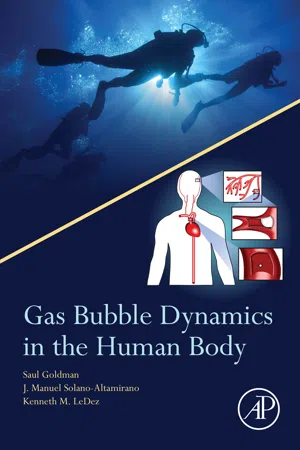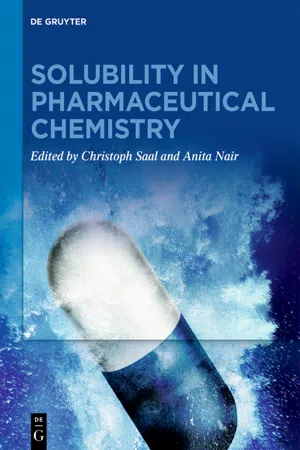Chemistry
Saturated Unsaturated and Supersaturated
Saturated, unsaturated, and supersaturated are terms used to describe the concentration of a solution. A saturated solution contains the maximum amount of solute that can be dissolved at a given temperature. An unsaturated solution can dissolve more solute, while a supersaturated solution contains more solute than should theoretically be possible at that temperature, often achieved through careful manipulation of conditions.
Written by Perlego with AI-assistance
Related key terms
Related key terms
1 of 4
Related key terms
1 of 3
3 Key excerpts on "Saturated Unsaturated and Supersaturated"
- eBook - ePub
- Saul Goldman, Manuel Solano-Altamirano, Kenneth Ledez(Authors)
- 2017(Publication Date)
- Academic Press(Publisher)
A logical starting point, before getting into how fast bubbles grow or shrink, is to explain why they grow or shrink—in principle. Anyone who has taken chemistry will have a rudimentary grasp of what “supersaturated,” “saturated,” and “undersaturated” mean. Most science undergraduates would know, for example, that a supersaturated solution is one that temporarily contains a higher solute concentration than it can maintain indefinitely. It will, sooner or later, release its excess solute to form a stable “saturated” solution . On the other hand, an “undersaturated” solution at a particular temperature and pressure would be understood to be one that contains a lower solute concentration than it can hold in solution indefinitely, at that temperature and pressure.While this level of understanding is fully correct as far as it goes, it will, for several reasons, have to be significantly augmented here. First, unlike the preceding example, we will in practice always be dealing with a gaseous solute mixture, as opposed to a pure solute. Undersaturation and supersaturation refer, in principle, to a state of imbalance with respect to the concentration of one specific substance, for example, N2 , or O2 , or H2 O, or CO2 , and not to a mixture of substances, that is, not, for example, to the mixture (N2 +O2 +H2 O+CO2 ). But because it is a gas mixture, such the latter, that is typically contained within a gas bubble in the body, an “effective” mixture-based supersaturation function will later be constructed for practical purposes (see Section 2.8 ).Second, undersaturation and supersaturation refer to a relative imbalance with respect to a specific solute distributed between a pair of phases. Therefore, for these terms to be meaningful, the two phases in question, in addition to the distributed solute, must be specified; for example, we must use specifications such as: N2 distributed between a gas bubble and arterial blood, or N2 distributed between a particular tissue and arterial blood, etc.In addition, gas bubbles, particularly those in the body, entail considerable physical complexity. For example, small gas bubbles are subject to an additional force due to surface tension. While surface tension can be omitted, as a good approximation, when dealing with large gas bubbles, its inclusion is essential for even a semiquantitative treatment of arterial gas emboli, which can be very small. - eBook - ePub
General Physics
Mechanics and Molecular Physics
- L D Landau(Author)
- 2013(Publication Date)
- Pergamon(Publisher)
saturated . If further solute is added to such a solution, it will not dissolve, and we can therefore say that a saturated solution is one which is in thermal equilibrium with the pure solute.The concentration of the saturated solution is a measure of the ability of a given substance to dissolve in the solvent concerned, and is also called simply the solubility of the substance.The solubility in general depends on the temperature. By means of Le Chatelier’s principle we may relate the nature of this dependence to the sign of the heat of solution. Let us suppose that dissolution is accompanied by absorption of heat (as when ammonium chloride is dissolved in water), and that we have a saturated solution in equilibrium with undissolved solid. If this system is heated it will no longer be in equilibrium, and processes must occur which tend to oppose the external interaction (heating) which has brought the substance out of equilibrium. In the present case this means that the solubility of the substance in water will increase so as to allow further dissolution, accompanied by absorption of heat.Thus, if dissolution is accompanied by absorption of heat, the solubility increases with temperature, but if heat is evolved on dissolution an increase in temperature will cause a decrease in solubility.The dissolution of a gas in a liquid is usually accompanied by a large decrease in volume: the volume of the solution is considerably less than the sum of the original volumes of the solvent and the dissolved gas (for example, when one mole of nitrogen is dissolved in a large quantity of water at room temperature and atmospheric pressure the volume of the liquid increases by only 40 cm3 , whereas the volume of this amount of gas is 22 400 cm3 - eBook - ePub
- Christoph Saal, Anita Nair, Christoph Saal, Anita Nair(Authors)
- 2020(Publication Date)
- De Gruyter(Publisher)
2 Solubility and supersaturationAnnette Bauer-BrandlDepartment of Physics, Chemistry and Pharmacy , University of Southern Denmark , Campusvej 55 , DK-5230 , Odense M.Martin BrandlDepartment of Physics, Chemistry and Pharmacy , University of Southern Denmark , Campusvej 55 , DK-5230 , Odense M.2.1 Introduction and fundamental considerations
Solubility and supersaturation are classical issues – for example in chemical engineering – regarding crystallization processes of chemical compounds. This aspect is addressed in detail in Chapter 10 of this book. Solubility and supersaturation are also relevant for pharmaceutical drug delivery: Supersaturable drug delivery systems are often used to increase the bioavailability of poorly soluble drugs that are administered as oral solid dosage forms (see Chapter 8). In order to understand their properties in a biopharmaceutical context, transient states of supersaturation need to be considered in settings, where dissolution media gradually change their compositions as is the case during passage through the digestive system. Under these circumstances, a clear distinction between solubility and supersaturation can become difficult, and the impact on dissolution rate, drug absorption rates, and bioavailability can be confusing. This chapter is intended to promote the understanding of these questions.2.1.1 Definitions and significance of solubility and supersaturation
2.1.1.1 Classical definitions of solubility and supersaturation
2.1.1.1.1 Solubility
Solubility of a solute (e.g., a drug substance) refers to the qualitative and quantitative composition of its saturated solution. This means that the solution is in a dynamic equilibrium between the solid particles of the solute in the form of a suspension in a given solvent that is kept under constant conditions (with respect to temperature, solvent composition, etc.). The solubility is expressed as the proportion of the designated solute in the designated solvent system.
Index pages curate the most relevant extracts from our library of academic textbooks. They’ve been created using an in-house natural language model (NLM), each adding context and meaning to key research topics.
Explore more topic indexes
Explore more topic indexes
1 of 6
Explore more topic indexes
1 of 4


